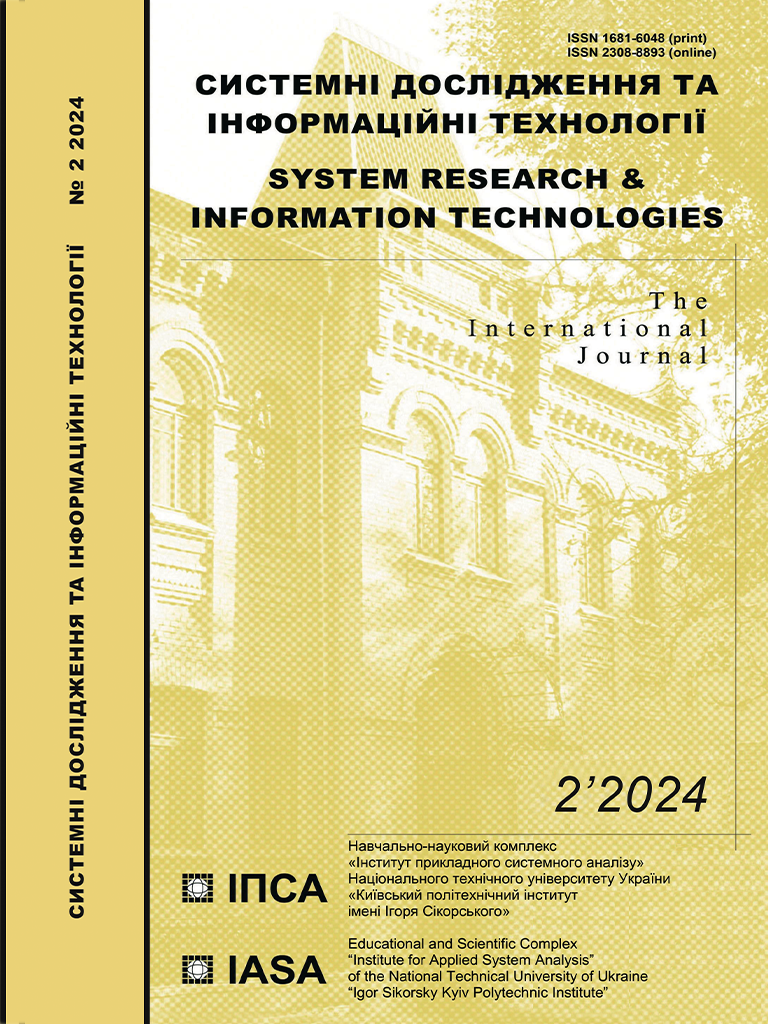A hybrid model of artificial intelligence integrated into GIS for predicting accidents in water supply networks
DOI:
https://doi.org/10.20535/SRIT.2308-8893.2024.2.04Keywords:
ANFIS, ACO, GA, spatial objects, geodatabase, metaheuristics, spatiotemporal analysis, water lossAbstract
The search for an effective and reliable model for predicting accidents on water supply networks by determining their exact locations has always been important for effectively managing water distribution systems. This study, based on the adaptive neuro-fuzzy logical inference system (ANFIS) model, was developed to predict accidents in the city of Kyiv (Ukraine) water supply network. The ANFIS model was combined with genetic algorithms and swarm optimization (ACO) methods and integrated into a GIS to visualize results and determine locations. Forecasts were evaluated according to the following criteria: mean absolute error (MAE), root mean square error (RMSE), and coefficient of determination (R2). Depending on the amount and type of input data, ANFIS optimization with genetic algorithms and swarm optimization (ACO) can, on average, increase the accuracy of ANFIS predictions by 10.1% to 11%. The obtained results indicate that the developed hybrid model may be successfully applied to predict accidents on water supply networks.
References
C.M. Fontanazza, V. Notaro, V. Puleo, P. Nicolosi, and G. Freni, “Contaminant intrusion through leaks in water distribution system: experimental Analysis,” Procedia Eng., 119, pp. 426–433, 2015. doi: 10.1016/j.proeng.2015.08.904.
“Urban Water Statistics Yearbook 2017,” (in Chinese), CUWA.
Dung H. Tran, A.W.M. Ng, and B.J.C. Perera, “Neural networks deterioration models for serviceability condition of buried stormwater pipes,” Engineering Applications of Artificial Intelligence, 20(8), pp. 1144–1151, 2007. doi: 10.1016/j.engappai.2007.02.005.
M. van Dijk, S.J. van Vuuren, J.E. van Zyl, “Optimising water distribution systems using a weighted penalty in a genetic algorithm”, Water SA, 35(5), pp. 537–548, 2008. doi: 10.4314/wsa.v34i5.180651.
M. Romano, Z. Kapelan, and D.A. Savic, “Evolutionary algorithm and expectation maximization strategies for improved detection of pipe bursts and other events in water distribution systems,” J. Water Resour. Plan. Manag., 140 (5), pp. 572–584, 2014. doi: 10.1061/(ASCE)WR.1943-5452.0000347.
J. Meseguer et al., “A decision support system for on-line leakage localization Environ,” Environmental Modelling & Software, vol. 60, pp. 331–345, 2014. doi: 10.1016/j.envsoft.2014.06.025.
Y. Wu and S. Liu “A review of data-driven approaches for burst detection in water distribution systems,” Urban Water J., 14 (9), pp. 972–983, 2017. doi: 10.1080/1573062X.2017.1279191.
C.J. Hutton, Z. Kapelan, L. Vamvakeridou-Lyroudia, and D.A. Savic, “Dealing with uncertainty in water distribution system models: a framework for real-time modeling and data assimilation,” J. Water Resour. Plan. Manag., 140 (2), pp. 169–183, 2014. doi: 10.1061/(ASCE)WR.1943-5452.0000325.
S.R. Mounce, A. Khan, A.S. Wood, A.J. Day, P.D. Widdop, and J. Machell, “Sensor-fusion of hydraulic data for burst detection and location in a treated water distribution system,” Inf. Fusion, 4 (3), pp. 217–229, 2003. doi: 10.1016/S1566-2535(03)00034-4.
B. Farley, S.R. Mounce, and J.B. Boxall, “Development and field validation of a burst localization methodology,” J. Water Resour. Plan. Manag., 139 (6), pp. 604–613, 2013. doi: 10.1061/(ASCE)WR.1943-5452.0000290.
M. Romano, Z. Kapelan, and D.A. Savic “Geostatistical techniques for approximate location of pipe burst events in water distribution systems” J. Hydroinf., 15 (3), pp. 634–651, 2013. doi: 10.2166/hydro.2013.094.
J. Kang, Y.J. Park, J. Lee, S.H. Wang, and D.S. Eom, “Novel leakage detection by ensemble cnn-svm and graph-based localization in water distribution systems,” IEEE Trans. Ind. Electron., 65 (5), pp. 4279–4289, 2018. doi: 10.1109/TIE.2017.2764861.
A.F. Colombo, P. Lee, and B.W. Karney, “A selective literature review of transient-based leak detection methods,” J. Hydro Environ. Res., 2 (4), pp. 212–227, 2009. doi: 10.1016/j.jher.2009.02.003.
H.R. Maier, A. Jain, G.C. Dandy, and K.P. Sudheer, “Methods used for the development of neural networks for the prediction of water resource variables in river systems: Current status and future directions. Environ,” Model. Softw., 25, pp. 891–909, 2010. doi: 10.1016/j.envsoft.2010.02.003.
D.T. Bui, B. Pradhan, H. Nampak, Q.-T. Bui, Q.-A. Tran, Q.-P. Nguyen, “Hybrid artificial intelligence approach based on neural fuzzy inference model and metaheuristic optimization for flood susceptibilitgy modeling in a high-frequency tropical cyclone area using GIS,” J. Hydrol., 540, pp. 317–330, 2016. doi: 10.1016/j.jhydrol.2016.06.027.
H. Ghalkhani, S. Golian, B. Saghafian, A. Farokhnia, and A. Shamseldin, “Application of surrogate artificial intelligent models for real-time flood routing,” Water Environ. J., 27(4), pp. 535–548, 2013. doi: 10.1111/j.1747-6593.2012.00344.x
M. Rezaeianzadeh, H. Tabari, A.A. Yazdi, S. Isik, and L. Kalin, “Flood flow forecasting using ANN, ANFIS and regression models,” Neural Comput. Appl., 25(1), pp. 25–37, 2013. doi: 10.1007/s00521-013-1443-6.
F.-J. Chang and M.-J. Tsai, “A nonlinear spatio-temporal lumping of radar rainfall for modeling multi-step-ahead inflow forecasts by data-driven techniques,” J. Hydrol., vol. 535, pp. 256–269, 2016. doi: 10.1016/j.jhydrol.2016.01.056.
Y.S. Güçlü and Z. Şen, “Hydrograph estimation with fuzzy chain model,” J. Hydrol., vol. 538, pp. 587–597, 2016. doi: 10.1016/j.jhydrol.2016.04.057.
A. Lohani, R. Kumar, and R. Singh, “Hydrological time series modeling: A comparison between adaptive neuro-fuzzy, neural network and autoregressive techniques,” J. Hydrol., vol. 442–443, pp. 23–35, 2012. doi: 10.1016/j.jhydrol.2012.03.031.
C.-J.F. Chung and A.G. Fabbri, “Validation of spatial prediction models for landslide hazard mapping,” Nat. Hazards, vol. 30, pp. 451–472, 2003. doi: 10.1023/B:NHAZ.0000007172.62651.2b.
K. Socha and C. Blum, “An ant colony optimization algorithm for continuous optimization: application to feed-forward neural network training,” Neural Computing and Applications, vol. 16(3), pp. 235–247, 2007. doi: 10.1007/s00521-007-0084-z.
C. Blum and K. Socha, “Training feed-forward neural networks with ant colony optimization: An application to pattern classification,” in Fifth International Conference on Hybrid Intelligent Systems (HIS’05), IEEE, 2005, November. doi: 10.1109/ICHIS.2005.104.
Omid Bozorg-Haddad, Mohammad Solgi, and Hugo A. Loáiciga, Meta-heuristic and Evolutionary Algorithms for Engineering Optimization. 2017. doi: DOI:10.1002/9781119387053.
“ArcGIS analysis workflows for public safety,” ESRI.

